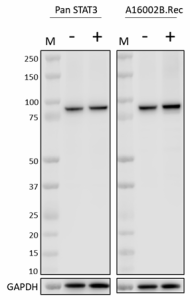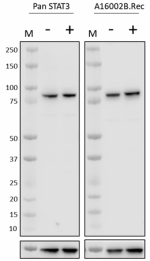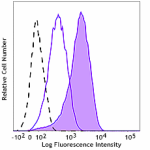- Clone
- A16002B.Rec (See other available formats)
- Regulatory Status
- RUO
- Other Names
- Signal transducer and activator of transcription 3, Acute-phase response factor, APRF, HIES
- Isotype
- Mouse IgG1, κ
- Ave. Rating
- Submit a Review
- Product Citations
- publications

-

Total cell lysates (15 µg total protein) from A-431 cells serum starved and untreated (-) or stimulated with 100 ng/mL recombinant human EGF (Cat. No. 585508) for 5 minutes (+) were resolved by 4-12% Bis-Tris gel electrophoresis, transferred to a PVDF membrane, and probed with 1 µg/mL (1:500 dilution) purified anti-STAT3 Phospho (Tyr705) recombinant antibody (clone A16002B.Rec), for 2 hours at room temperature. Proteins were visualized by chemiluminescence detection using HRP goat anti-mouse IgG antibody (Cat. No. 405306) at 2.0 µg/mL. Purified anti-STAT3 antibody (clone 4G4B45) (Cat. No. 678002), was used as a pan STAT3 control at 1.0 µg/mL (1:500 dilution). Direct-Blot™ HRP anti-GAPDH antibody (Cat. No. 607904) was used as a loading control at a 1:50000 dilution (lower). Lane M: Molecular weight marker. -

Total cell lysates (15 µg total protein) from NIH/3T3 cells untreated (-) or stimulated with 10 ng/mL recombinant mouse IL-6 (Cat. No. 575708) for 20 minutes (+) were resolved by 4-12% Bis-Tris gel electrophoresis, transferred to a PVDF membrane, and probed with 1 µg/mL (1:500 dilution) purified anti-STAT3 Phospho (Tyr705) recombinant antibody (clone A16002B.Rec) for 2 hours at room temperature. Proteins were visualized by chemiluminescence detection using HRP goat anti-mouse IgG antibody (Cat. No. 405306) at a 2.0 µg/mL. Purified anti-STAT3 pan antibody (clone 4G4B45) (Cat. No. 678002), was used as a pan STAT3 control at 1.0 µg/mL (1:500 dilution). Direct-Blot™ HRP anti-GAPDH antibody (Cat. No. 607904) was used as a loading control at a 1:50000 dilution (lower). Lane M: Molecular weight marker. -

NIH/3T3 cells were untreated (panel A) or stimulated with 10 ng/mL recombinant mouse IL-6 (Cat. No. 575708) for 20 minutes (panel B). Cells were fixed with 4% paraformaldehyde for 10 minutes, permeabilized with ice-cold methanol, and blocked with 5% FBS for 60 minutes. Fixed cells were then intracellularly stained with 5 µg/mL (1:100 dilution) purified anti-STAT3 Phospho (Tyr705) recombinant antibody (clone A16002B.Rec) for 2 hours at room temperature, after which proteins were visualized with Alexa Fluor® 594 goat anti-mouse IgG antibody (Cat. No. 405326) at 2.0 µg/mL. Nuclei were counterstained with DAPI, and the image was captured with a 60X objective. -

A431 cells untreated (low expression control, open histogram), or treated with human EGF (100 ng/mL) (positive control, solid histogram) were fixed and permeabilized using True Phos™ Perm Buffer (Cat. No. 425401) and intracellularly stained with purified anti-Stat3 Phospho (Tyr705) (clone A16002B.Rec), or purified Mouse IgG1, κ isotype control (Cat. No. 401401) (Open histogram, dashed line)(representative histogram for untreated and treated cells) followed by Alexa Fluor® 647 anti-mouse IgG (Cat. No. 405322).
| Cat # | Size | Price | Quantity Check Availability | Save | ||
|---|---|---|---|---|---|---|
| 690451 | 25 µg | 113€ | ||||
| 690452 | 100 µg | 264€ | ||||
Tyrosine phosphorylation of STAT3 at Tyr705 occurs in response to LIF, IL-6, leptin, OSM, EGF, PDGF, and HGF. It plays a key role in cell growth and apoptosis through mediating expression of a variety of genes in response to the stimuli.
Product DetailsProduct Details
- Verified Reactivity
- Human, Mouse
- Antibody Type
- Recombinant
- Host Species
- Mouse
- Immunogen
- Synthetic peptide corresponding to STAT3 phosphorylated at tyrosine 705
- Formulation
- Phosphate-buffered solution, pH 7.2, containing 0.09% sodium azide
- Preparation
- The antibody was purified by affinity chromatography.
- Concentration
- 0.5 mg/mL
- Storage & Handling
- The antibody solution should be stored undiluted between 2°C and 8°C.
- Application
-
WB - Quality tested
ICC, ICFC - Verified - Recommended Usage
-
Each lot of this antibody is quality control tested by western blotting. For western blotting, the suggested use of this reagent is 0.5 - 1.0 µg/mL. For immunocytochemistry, a concentration range of 5.0 - 10.0 μg/mL is recommended. For flow cytometric staining using our True-Phos™ Perm Buffer in Cell Suspensions Protocol, the suggested use of this reagent is ≤ 0.06 µg per million cells in 100 µL volume. It is recommended that the reagent be titrated for optimal performance for each application.
- Application Notes
-
This clone shows high pan-reactivity to STAT3 when used for WB. BioLegend clone 13A3-1 is more suitable for phospho-specific detection of STAT3.
This recombinant antibody clone is derived from clone A16002B. - RRID
-
AB_2894516 (BioLegend Cat. No. 690451)
AB_2894516 (BioLegend Cat. No. 690452)
Antigen Details
- Structure
- STAT3 is a 770 amino acid protein of 88 kD. It consists of a DNA binding domain, a SH2 domain, a regulatory tyrosine responsible for binding of SH2 domain, and a C-terminal transactivation domain.
- Distribution
-
Ubiquitous
- Function
- STAT3 is tyrosine phosphorylated by receptor kinases in response to a variety of cytokines and growth factors. It forms homo- or heterodimer with STAT1 when tyrosine is phosphorylated, and then translocates to nucleus, acting as a transcription regulator. It is also essential for the differentiation of TH17 cells, which is involved in autoimmune diseases. The small GTPase Rac1 binds and regulates activity of STAT3.
- Ligand/Receptor
- When activated, STAT3 dimerizes and translocates to the nucleus where it regulates gene expression
- Cell Type
- Embryonic Stem Cells
- Biology Area
- Cell Biology, Neuroscience, Neuroscience Cell Markers, Signal Transduction, Stem Cells
- Molecular Family
- Nuclear Markers, Phospho-Proteins
- Antigen References
-
- Akira S, et al. 1994. Cell. 77:63.
- Zhang X, et al. 1995. Science. 267:1990.
- Sanchez-Margalet V, et al. 2001. Cell Immunol. 211:30.
- Simon A, et al. 2000. Science. 290:144.
- Hoey T, et al. 1999. Adv Immunol. 71:145.
- Gene ID
- 6774 View all products for this Gene ID
- UniProt
- View information about STAT3 on UniProt.org
Related Pages & Pathways
Pages
Related FAQs
Other Formats
View All STAT3 Reagents Request Custom Conjugation| Description | Clone | Applications |
|---|---|---|
| Purified anti-STAT3 Phospho (Tyr705) Recombinant Antibody | A16002B.Rec | WB,ICC,ICFC |
Compare Data Across All Formats
This data display is provided for general comparisons between formats.
Your actual data may vary due to variations in samples, target cells, instruments and their settings, staining conditions, and other factors.
If you need assistance with selecting the best format contact our expert technical support team.
-
Purified anti-STAT3 Phospho (Tyr705) Recombinant Antibody

Total cell lysates (15 µg total protein) from A-431 cells se... 
Total cell lysates (15 µg total protein) from NIH/3T3 cells ... 
NIH/3T3 cells were untreated (panel A) or stimulated with 10... 
A431 cells untreated (low expression control, open histogram...
 Login / Register
Login / Register 







Follow Us